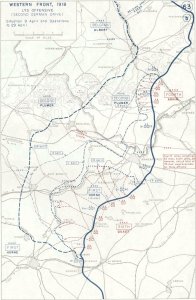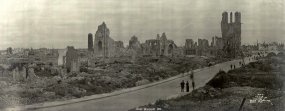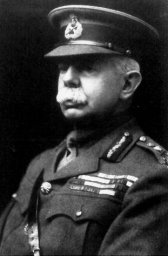
WWII: Maginot Line | Normandy | V-Weapon Sites | Arnhem
Further afield: Crete
| Home Tracing Military Ancestors Travel Advice CWGC Cemeteries Iron Harvest News Book Reviews Glossary Links Contact Me Ypres:
 
|
The Fourth Battle of Ypres (April 1918)The German 1918 Offensive on the Western Front was essentially their final attempt to win the war before major American reinforcements arrived in France. Using the troops released from the Eastern Front by the Russian collapse and backed by a "battering ram" of 6,000 guns, Ludendorff, the German Commander-in-Chief, planned to bludgeon his way out of the trench deadlock. The offensive was unleashed on 21st March 1918 against the British 5th Army on the Somme. Assisted by thick fog, a crushing bombardment from their huge artillery train and spearheaded by specially trained "storm-troopers", the British front was torn to shreds. By 4th April, the Germans had reached Amiens but the British began to rally, casualties mounted and the advance slowed. To regain the initiative Ludendorff launched Operation George on the Ypres front. He aimed to cross the River Lys and capture the “Flanders hills” to the south of Ypres as well as the important rail interchange at Hazebrouck. With Ypres outflanked he could finally bring about its surrender, capture the Channel Ports and cut the British off from their supply lines. It was an audacious plan. On 9th April, preceded by another saturating bombardment, eight divisions of the German Sixth Army attacked the British line south of Armentières. The sector was held by a Portuguese division, which practically melted away under the onslaught. Nearby British units tried to hold their ground and some, on the flanks of the German advance, succeeded in holding back the tide, but the Germans were determined to finish the fight. Pressing their advantage in numbers they crossed the River Lys and, on 10th April, opened a second massive attack, this time with the Fourth Army driving headlong due west across the Messines Ridge. Villages and features that had cost thousands of lives to capture in Third Ypres were overrun within hours (Tour Guide – Hyde Park Corner Memorial).
The situation was so serious that, on 11th April, Haig issued a “Special Order of the Day” that put the British Army’s plight in the starkest terms imaginable: “There is no other course open to us but to fight it out. Every position must be held to the last man: there must be no retirement. With our backs to the wall and believing in the justice of our cause each one of us must fight on to the end. The safety of our homes and the Freedom of mankind alike depend upon the conduct of each one of us at this critical moment”. It was at this juncture that Haig put General Plumer, the victor of Messines, in command of all the troops defending the Salient. It was he who took the bitter decision to withdraw from the Passchendaele Ridge. The Germans now opened a third front – through Langemarck they came, chasing the British back down into Ypres itself. They were stopped at “Hell Fire Corner” – just a few hundred yards from the Cloth Hall.
Ludendorff now thrust straight for the “Flanders hills” – Kemmel, Mont Noir, Mont Rouge and Mont des Cats. On 25th April a lightning attack on Kemmel took the hill from recently arrived French reinforcements. Although a last-ditch counterattack by British and French reserves, fighting side-by-side, managed to halt the German advance outside the village of Locre, it seemed that one more push would seal Ypres’ fate and that of its redoubtable defenders. Lundendorff, however, had nothing left to give. After weeks of almost continuous advance his troops were exhausted. The poor ground conditions, so often the bane of British generals, were now proving to be the undoing of Operation George. Bogged down in the mud, guns could not be brought up to support the advance and supplies could not reach the forward troops. The British, though outnumbered, had not broken and continued to fight, sapping the strength of the German assault. Since the 21st March breakthrough on the Somme, the British had suffered 240,000 casualties, but German losses had reached over 350,000. Such attrition could not be sustained indefinitely. On 29th April Ludendorff called off the operation. The threat to Ypres was over.
******************
The defeat of Operation George was not the last German attack on the Western Front but the endgame was well and truly underway. Further offensives in the south towards Paris made ever more limited gains as American reinforcements, a resurgent French Army and pulverising British counterattacks paved the way for a general advance that, by November 1918, had forced the Germans to agree an Armistice. The war was over. In Ypres the British Empire built a memorial to their missing. The Menin Gate, as it is known, commands the eastern exit from the town through which so many young men marched, never to return. On the inside of its great arch, on its colonnaded sides and in the connecting stairwells are etched in stone the names of nearly 55,000 who fought in the great defence of the town. On its inauguration, in 1927, it fell to Lord Plumer to pay tribute to these men when he glanced around and uttered with emotion, “He is not missing. He is here.”… (Tour Guide – Menin Gate, Ypres and Lijssenthoek CWGC Cemetery, Poperinghe) |




